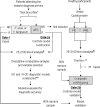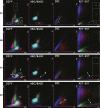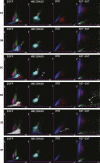Design of malaria diagnostic criteria for the Sysmex XE-2100 hematology analyzer
- PMID: 20207864
- PMCID: PMC2829900
- DOI: 10.4269/ajtmh.2010.09-0464
Design of malaria diagnostic criteria for the Sysmex XE-2100 hematology analyzer
Abstract
Thick film, the standard diagnostic procedure for malaria, is not always ordered promptly. A failsafe diagnostic strategy using an XE-2100 analyzer is proposed, and for this strategy, malaria diagnostic models for the XE-2100 were developed and tested for accuracy. Two hundred eighty-one samples were distributed into Plasmodium vivax, P. falciparum, and acute febrile syndrome groups for model construction. Model validation was performed using 60% of malaria cases and a composite control group of samples from AFS and healthy participants from endemic and non-endemic regions. For P. vivax, two observer-dependent models (accuracy = 95.3-96.9%), one non-observer-dependent model using built-in variables (accuracy = 94.7%), and one non-observer-dependent model using new and built-in variables (accuracy = 96.8%) were developed. For P. falciparum, two non-observer-dependent models (accuracies = 85% and 89%) were developed. These models could be used by health personnel or be integrated as a malaria alarm for the XE-2100 to prompt early malaria microscopic diagnosis.
Conflict of interest statement
Disclosure: Some of the authors wish to disclose that they have received technical support (two consultancies) from the Sysmex Corporation regarding this project in relation to accessing the hematology analyzer's technical variable database. No direct funding or benefits such as trips, conference participations, or commercial contracts have been offered or received by Sysmex Corporation regarding the research presented in the submitted paper. This statement is made in the interest of full disclosure and not because the authors consider this to be a conflict of interest.
Figures



Similar articles
-
Use of Sysmex XE-2100 and XE-5000 hematology analyzers for the diagnosis of malaria in a nonendemic country (France).Int J Lab Hematol. 2014 Apr;36(2):124-34. doi: 10.1111/ijlh.12145. Epub 2013 Sep 6. Int J Lab Hematol. 2014. PMID: 24034163
-
Automated detection of malaria-associated pseudoeosinophilia and abnormal WBC scattergram by the Sysmex XE-2100 hematology analyzer: a clinical study with 1,801 patients and real-time quantitative PCR analysis in vivax malaria-endemic area.Am J Trop Med Hyg. 2010 Mar;82(3):412-4. doi: 10.4269/ajtmh.2010.09-0560. Am J Trop Med Hyg. 2010. PMID: 20207865 Free PMC article.
-
Automated detection of malaria with haematology analyzer Sysmex XE-2100.Indian J Med Sci. 2011 Jan;65(1):26-31. Indian J Med Sci. 2011. PMID: 23134943 Clinical Trial.
-
Abnormal WBC scattergram: a clue to the diagnosis of malaria.Hematology. 2013 Mar;18(2):101-5. doi: 10.1179/1607845412Y.0000000029. Epub 2012 Sep 12. Hematology. 2013. PMID: 22980408
-
Diagnostic role of Sysmex hematology analyzer in the detection of malaria: A systematic review and meta-analysis.PLoS One. 2024 Sep 6;19(9):e0296766. doi: 10.1371/journal.pone.0296766. eCollection 2024. PLoS One. 2024. PMID: 39240990 Free PMC article.
Cited by
-
White blood cell differential fluorescence abnormal scattergram: A useful indicator for early detection of malarial parasite.Pak J Med Sci. 2022 Mar-Apr;38(3Part-I):687-691. doi: 10.12669/pjms.38.3.4702. Pak J Med Sci. 2022. PMID: 35480534 Free PMC article.
-
Application of Sysmex XN-Series Automated Haematology Analyser in the Rapid Detection of Malaria.Indian J Hematol Blood Transfus. 2020 Jul;36(3):512-518. doi: 10.1007/s12288-020-01276-x. Epub 2020 Apr 3. Indian J Hematol Blood Transfus. 2020. PMID: 32647426 Free PMC article.
-
Congenital malaria in China.PLoS Negl Trop Dis. 2014 Mar 13;8(3):e2622. doi: 10.1371/journal.pntd.0002622. eCollection 2014 Mar. PLoS Negl Trop Dis. 2014. PMID: 24626148 Free PMC article. Review.
-
Automated Hematology Analyzers in Diagnosis of Plasmodium vivax Malaria: an Adjunct to Conventional Microscopy.Mediterr J Hematol Infect Dis. 2014 Jun 1;6(1):e2014034. doi: 10.4084/MJHID.2014.034. eCollection 2014. Mediterr J Hematol Infect Dis. 2014. PMID: 24959331 Free PMC article.
-
Diagnostic accuracy of fluorescence flow-cytometry technology using Sysmex XN-31 for imported malaria in a non-endemic setting.Parasite. 2022;29:31. doi: 10.1051/parasite/2022031. Epub 2022 May 31. Parasite. 2022. PMID: 35638753 Free PMC article.
References
-
- Newman RD, Parise ME, Barber AM, Steketee RW. Malaria-related deaths among U.S. travelers, 1963–2001. Ann Intern Med. 2004;141:547–555. - PubMed
-
- Lema OE, Carter JY, Nagelkerke N, Wangai MW, Kitenge P, Gikunda SM, Arube PA, Munafu CG, Materu SF, Adhiambo CA, Mukunza HK. Comparison of five methods of malaria detection in the outpatient setting. Am J Trop Med Hyg. 1999;60:177–182. - PubMed
-
- Mendelow BV, Lyons C, Nhlangothi P, Tana M, Munster M, Wypkema E, Liebowitz L, Marshall L, Scott S, Coetzer TL. Automated malaria detection by depolarization of laser light. Br J Haematol. 1999;104:499–503. - PubMed
-
- Fourcade C, Casbas MJ, Belaouni H, Gonzalez JJ, Garcia PJ, Pepio MA. Automated detection of malaria by means of the haematology analyser Coulter GEN.S. Clin Lab Haematol. 2004;26:367–372. - PubMed
-
- Huh HJ, Oh GY, Huh JW, Chae SL. Malaria detection with the Sysmex XE-2100 hematology analyzer using pseudoeosinophilia and abnormal WBC scattergram. Ann Hematol. 2008;87:755–759. - PubMed
Publication types
MeSH terms
LinkOut - more resources
Full Text Sources
Other Literature Sources

